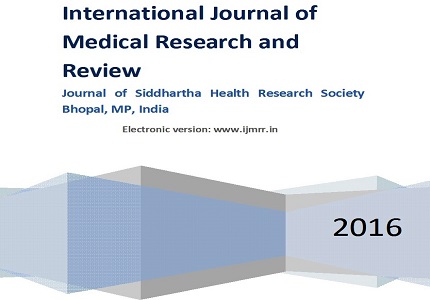Microbial profile and risk factors of central venous catheter associated blood stream infections in Tertiary Care Hospital, Amritsar
Abstract
Introduction: Central venous catheter (CVC) related blood stream infections are associated with serious infectious complications resulting in significant morbidity, increased duration of hospitalization and added medical cost.
Aim: The study was done to determine the incidence of central venous catheter related infections, their antimicrobial sensitivity pattern, biofilm production and associated risk factors in hospitalized patients.
Material and Method: Catheter tip culture & blood cultures of 143 patients with indwelling central venous catheters were processed.
Result: Out of 143 specimens, catheter tip colonization was observed in 45 samples, while 14 were both catheter tip as well as blood culture positive hence included ascatheter related blood stream infections (CRBSI). CRBSI was found significantly associated with increased duration of catheterization, increased number of attempts and placement of CVC in internal jugular vein. Most common isolated organisms were Klebsiella pneumoniae followed by Coagulase negative Staphylococcus, Staphylococcus aureus and Pseudomonas aerguinosa in CRBSI as well as in CVC colonization. Majority of them were resistant to Gentamicin, Ciprofloxacin, Ceftiazidime and Ceftrixone. Biofilm production was determined by tissue culture plate method and was found to be maximum seen in Klebsiella spp.
Conclusion: Incidence of CRBSI was 9.79% and of CVC colonization was 34.26%. Rate of CRBSI was 8.53 per 1000 CVC days. Klebsiella pneumoniae was most common isolate and predominant biofilm producer and was found to be multidrug resistant to Gentamicin, Ciprofloxacin, Ceftiazidime.
Downloads
References
2. Donlan RM. Biofilms and device-associated infections. Emerg Infect Dis. 2001 Mar-Apr;7(2):277-81. [PubMed]
3. Mermel LA, Allon M, Bouza E ET AL. Clinical practice guidelines for the diagnosis and management of intravascular catheter-related infection: 2009 Update by the Infectious Diseases Society of America. Clin Infect Dis. 2009 Jul 1;49(1):1-45. doi: 10.1086/599376.
4. Maki DG, Weise CE, Sarafin HW. A semiquantitative culture method for identifying intravenous-catheter-related infection. N Engl J Med. 1977 Jun 9;296(23):1305-9. [PubMed]
5. Mackie TJ, McCartney JE. Mackie and McCartney Practical Medical Microbiology. 14thed. Collee JG, Frazer AG, Marmion BP, Simmons A, editors. New Delhi:Elsevier;2007.
6. ChanderJ.Textbook of medical Mycology.3rd ed.NewDelhi:Mehta Publisher;2010.
7. Clinical Laboratories Standard Institute. Performance standards for antimicrobial disks susceptibility tests. Approved standards, 11th ed. CLSI document M2-A12. CLSI, Wayne, PA: CLSI 2012.
8. Mathur T, Singhal S, Khan S, Upadhyay DJ, Fatma T, Rattan A. Detection of biofilm formation among the clinical isolates of Staphylococci: an evaluation of three different screening methods. Indian J Med Microbiol. 2006 Jan;24(1):25-9. [PubMed]
9. Wayne PA. Clinical and laboratory standard institute 2006. Performance standard for antimicrobial disc tests. Approved standards, 9th ed;sixteenth informational supplement M2-M9.2006:26.
10. Chopdekar K, Chande C, Chavan S, Veer P, Wabale V, Vishwakarma K, Joshi A. Central venous catheter-related blood stream infection rate in critical care units in a tertiary care, teaching hospital in Mumbai. Indian J Med Microbiol. 2011 Apr-Jun;29(2):169-71. doi: 10.4103/0255-0857.81796.
11. Kaur M, Gupta V, Gombar S, Chander J, Sahoo T. Incidence, risk factors, microbiology of venous catheter associated bloodstream infections - A prospective study from a tertiary care hospital. Indian J Med Microbiol 2015; 33: 248-54.doi: 10.4103/0255-0857.153572. [PubMed]
12. Kaur R, Mathai AS, Abraham J. Mechanical and infectious complications of central venous catheterizations in a tertiary-level intensive care unit in northern India. Indian J Anaesth. 2012 Jul;56(4):376-81. doi: 10.4103/0019-5049.100823.
13. Patil HV, Patil VC, Ramteerthkar MN, Kulkarni RD.Central venous catheter-related bloodstream infections in the intensive care unit. Indian J Crit Care Med. 2011 Oct;15(4):213-23. doi: 10.4103/0972-5229.92074. [PubMed]
14. Mansur FJ, Barai L, Karim MM, Haq JA, Fatema K, Faruq MO. Intravascular catheter related infections and antimicrobial susceptibility pattern of isolated bacteria in a tertiary care hospital of Bangladesh. Indian J Med Microbiol 2014; 32: 68-71.doi: 10.4103/0255-0857.124321.



 OAI - Open Archives Initiative
OAI - Open Archives Initiative


